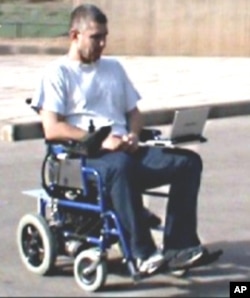Reasearchers in Israel have developed an electronic controller that allows severely disabled people to control their wheelchairs or computers with a simple sniff of the nose.
Injury or disease can leave people paralyzed virtually from the neck down, often without any impairment of their mental capabilities. This new technology uses a hypersensitive device that allows severely disabled people to communicate and move about, using their nose.
Smell away
Quadriplegia can leave individuals without the use of their limbs or torso, but the degree of control from the neck up varies.
Even more severe is the "trapped in" or "locked in" syndrome, where individuals are completely paralyzed but still have full use of their mental faculties.
There are several existing technologies that can help such people with communication and mobility. These systems can be controlled by changing the position of the tongue, moving the eye, or, sipping or puffing on a straw. However, sniff technology presents new opportunities.
Noam Sobel is a professor at the Department of Neurobiology at the Weizmann Institute of Science in Israel, where this technology was developed. His lab discovered that people can actually sniff very fast and very accurately, producing a very rich signal.
Sniff control
"It contains digital information. You have sniff onset and sniff offset, and you can sniff in and out. And it also contains analog information because you can sniff with greater or lesser magnitude, or for faster or shorter durations," he explains. "And, so, all those pieces of information together can be used to generate an incredible wealth of control."
So long as they still have control of their soft palate - the soft tissue at the back of the mouth - many completely paralyzed people can control whether air flows through their nose or their mouth. For many users, this can come easily, perhaps because sniffing is controlled similarly to language in the brain.
Sobel demonstrates this over the phone, talking in a very nasal tone while his soft palate is closed, and then speaking normally when his soft palate is open. With practice, he says, it is possible to control a wheelchair and talk at the same time, something that is difficult to do with other technologies such as tongue control or sip-puff.
Price is right
Controllers activated by eye movements are currently the best communication option for "trapped-in" individuals, but Sobel's sniff technology offers an alternative.
With the use of a special mask, trapped-in individuals on a respirator can open or close their soft palate, changing the air pressure in the mask. Electronics measure these changes in pressure, which can be used as a signal to a communication device.
Another benefit of this technology is cost. Sobel built a stand-alone sniff controller for an electric wheelchair for $358. That's significantly cheaper than an eye tracking device, which can cost up to $20,000.
Sobel estimates that if sniff technology is mass-produced, it could be made for only tens of dollars.
Immediate impact
Eric Larson of the National Spinal Cord Injury Association works with researchers to help them understand the needs of individuals with spinal cord injuries.
He says that work like Sobel's is exciting to see, since it can have an immediate, tangible impact on lives.
"Part of our role is to make people aware of new technologies, new opportunities like this, while at the same time, we need to manage expectations. But if people know that it's in the pipeline, it can bring people a sense of hope."
And, in this case, hope for quadriplegics and others living with severe disabilities might be just a sniff away.














